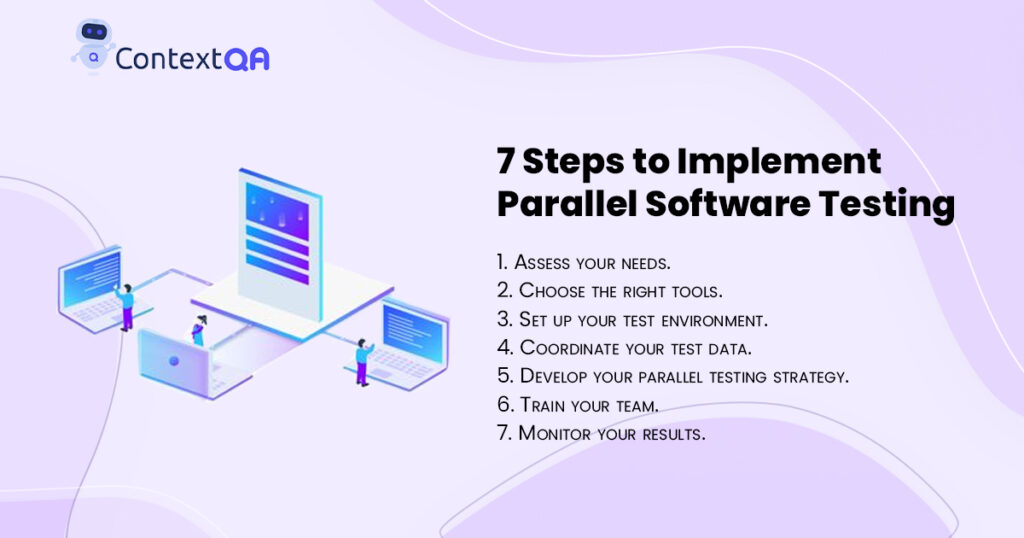Parallel software testing is a method of executing multiple tests simultaneously. This can be done in a number of ways, such as running tests on different machines, in different threads, or in different browsers.
Parallel testing can significantly reduce the time it takes to test software, especially for large and complex applications.
Says James Bach, software testing expert "Parallel testing is one of the most important things you can do to improve the efficiency and effectiveness of your software testing process."
Benefits of Parallel Software Testing

There are a number of benefits to implementing parallel software testing in your organization, including:
Reduced testing time:
Parallel testing can significantly reduce the time it takes to test software. This is because multiple tests can be executed simultaneously, rather than one at a time.
Improved test coverage:
Parallel testing can help to improve test coverage by allowing you to run more tests in a shorter amount of time. This can be especially beneficial for large and complex applications.
Earlier detection of bugs:
Parallel testing can help you to detect bugs earlier in the development process. This is because you can run more tests more frequently, which means that you are more likely to find bugs before they cause problems in production.
Improved quality of software:
Parallel testing can help to improve the quality of your software by ensuring that it is thoroughly tested before it is released to production. This can reduce the number of bugs that are found in production and improve the overall user experience.
Challenges of Parallel Software Testing
While parallel software testing offers a number of benefits, there are also some challenges that need to be considered. These challenges include:
- Test environment setup: Parallel testing can require more complex test environment setup than sequential testing. This is because you need to ensure that all of the test machines or threads have access to the same test data and resources.
- Test data coordination: Parallel testing can also require more complex test data coordination than sequential testing. This is because you need to ensure that the test data is synchronized across all of the test machines or threads.
- Test failure analysis: Parallel testing can also make it more difficult to analyze test failures. This is because multiple tests may be running simultaneously, and it can be difficult to determine which test caused a particular failure.
How to Implement Parallel Software Testing in Your Organization

If you are considering implementing parallel software testing in your organization, there are a number of things you need to do.
Assess your needs.
The first step is to assess your needs and determine whether parallel testing is right for you. Consider the size and complexity of your software application, as well as your budget and resources.
Choose the right tools.
There are a number of tools available that can help you to implement parallel software testing. Choose the tools that are right for your organization and your specific needs.
Set up your test environment.
As mentioned above, parallel testing can require more complex test environment setup than sequential testing. Make sure that you have all of the necessary hardware and software in place before you start parallel testing.
Coordinate your test data.
Parallel testing can also require more complex test data coordination than sequential testing. Make sure that you have a plan in place for synchronizing the test data across all of the test machines or threads.
Develop your parallel testing strategy.
Once you have all of the necessary tools and infrastructure in place, you need to develop your parallel testing strategy. This strategy should define how you will group your tests, how you will distribute them to the test machines or threads, and how you will handle test failures.
Train your team.
Parallel software testing can be more complex than sequential testing, so it is important to train your team on how to use the new tools and processes.
Monitor your results.
Once you start parallel testing, it is important to monitor your results carefully. This will help you to identify any problems and make necessary adjustments to your strategy.
Book a Demo and experience ContextQA testing tool in action with a complimentary, no-obligation session tailored to your business needs.
Increasing Popularity of Parallel Software Testing
According to a recent survey, 75% of software organizations are using parallel testing. This shows that parallel testing is becoming increasingly popular, as organizations recognize the benefits that it can offer.
Another recent study found that parallel testing can reduce the time it takes to test software by up to 50%. This shows that parallel testing can significantly improve the efficiency of your software testing process.
You may also be interested in: The Best Software Testing Tools for 2023
